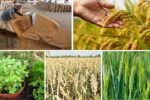Sugar is one of the most essential commodities in the world. From sweetening our beverages to being a vital ingredient in countless food products, its significance spans culinary, industrial, and economic realms. Globally, sugar production supports millions of livelihoods and fuels large-scale industries, particularly in developing countries. Understanding which country leads in sugar production not only provides insight into agricultural dominance but also highlights the socio-economic importance of this commodity. So, which country is the largest sugar producer in the world? The answer lies in the tropical fields of Brazil, a nation that has long maintained its stronghold as the world leader in sugar production.
1. Global Overview of Sugar Production

Sugar is primarily derived from two crops: sugarcane and sugar beet. While sugarcane grows in warm, tropical climates, sugar beet thrives in cooler temperate zones. More than 70% of the world’s sugar is produced from sugarcane, with the rest coming from sugar beet.
The global sugar industry is a major contributor to the economy in many countries. According to the Food and Agriculture Organization (FAO) and the United States Department of Agriculture (USDA), global sugar production hovers around 180 to 190 million metric tons annually.
Key players in global sugar production include:
- Brazil
- India
- Thailand
- China
- United States
- Mexico
- Pakistan
- Russia
Among these, Brazil has consistently dominated the charts, producing the largest share of global sugar.
2. Brazil – The Sugar Powerhouse of the World

2.1. Total Production Statistics
As of the latest data from 2023–2024, Brazil produced approximately 42 million metric tons of sugar, making it the largest sugar producer in the world. It accounts for nearly 20–22% of global sugar production and over 40% of global sugar exports.
2.2. Sugarcane Dominance
Brazil’s sugar production comes almost entirely from sugarcane, grown extensively in the country’s southeastern states such as:
- São Paulo
- Minas Gerais
- Paraná
- Goiás
The country’s vast arable land, favorable tropical climate, and advanced agricultural technologies contribute to high crop yields.
2.3. Dual-purpose Crop – Sugar and Ethanol
What sets Brazil apart is its flexible sugarcane processing system. Sugarcane is not only used for sugar production but also for ethanol, a biofuel. Brazil’s sugar mills can switch between sugar and ethanol production based on global market demand and prices, making the country a global model in sugar-energy integration.
3. Government Policies and Infrastructure
3.1. Supportive Policies
The Brazilian government has long supported the sugar and ethanol industries. During the 1970s oil crisis, Brazil launched the Proálcool Program to reduce its dependence on imported fossil fuels by encouraging ethanol use, which boosted sugarcane cultivation.
3.2. Investment in Infrastructure
Brazil has invested heavily in:
- Agricultural research (via Embrapa)
- Mechanized harvesting
- Efficient transportation and port facilities for exports
These factors have helped Brazil maintain its position as the world’s top sugar producer.
4. India – A Close Competitor
While Brazil leads globally, India is the second-largest producer of sugar, often competing closely in total output. In some years (e.g., 2021–22), India temporarily surpassed Brazil in production due to climatic factors affecting Brazil’s sugarcane crop.
India produced around 35–37 million metric tons of sugar in 2023–24, mainly in the states of:
- Uttar Pradesh
- Maharashtra
- Karnataka
However, India’s sugar is largely consumed domestically, with limited exports compared to Brazil.
5. Comparison with Other Major Producers

| Country | Production (2023–24) | Export Volume | Main Source |
|---|---|---|---|
| Brazil | ~42 million tons | Very High | Sugarcane |
| India | ~36 million tons | Moderate | Sugarcane |
| Thailand | ~11 million tons | High | Sugarcane |
| China | ~10 million tons | Low | Sugarcane & Beet |
| USA | ~8 million tons | Low | Sugar Beet |
| Pakistan | ~7 million tons | Low | Sugarcane |
6. Brazil’s Role in the Global Sugar Market
6.1. Export Leadership
Brazil is the world’s largest exporter of sugar, accounting for over 40% of global exports. Its primary markets include:
- China
- Indonesia
- Bangladesh
- United Arab Emirates
- Algeria
6.2. Influence on Global Prices
Due to its dominant position, any changes in Brazil’s sugarcane yield or export policies can significantly impact global sugar prices. A drought, frost, or shift in ethanol demand in Brazil can ripple through the international market.
7. Challenges Facing Brazil’s Sugar Industry

Despite its dominance, Brazil’s sugar industry faces several challenges:
- Climatic vulnerabilities: Droughts and frosts can affect yields.
- Labor and environmental concerns: Manual harvesting, though reduced, still raises ethical and sustainability issues.
- Global competition and tariffs: International trade policies and subsidies can affect Brazil’s market access.
However, continuous innovation, government support, and private investment have allowed Brazil to remain resilient and adaptable.
8. Future Outlook

Brazil is expected to retain its leadership in the global sugar market due to:
- Continued investment in sustainable production
- Advances in genetically modified sugarcane for higher yields
- Growth in demand for bioethanol as an alternative fuel
- Expanding export markets, especially in Asia and the Middle East
Moreover, the integration of AI, drone monitoring, and climate-smart agriculture will further optimize production efficiency in Brazil.
Conclusion
To answer the thesis question, Brazil is unequivocally the largest sugar producer in the world, not only in raw production volume but also in export dominance and industry integration. Its agricultural prowess, flexible processing capacity, and global market leadership make it the sugar capital of the world. As climate change, sustainability, and energy diversification become central themes of the global economy, Brazil’s model of combining sugar and ethanol production may serve as a blueprint for other nations.
Understanding Brazil’s leadership in sugar production offers valuable lessons in agribusiness, sustainable energy, and international trade. As global demand for sugar and ethanol continues to grow, Brazil’s position as a sugar superpower is likely to remain unchallenged for years to come.




Leave A Comment